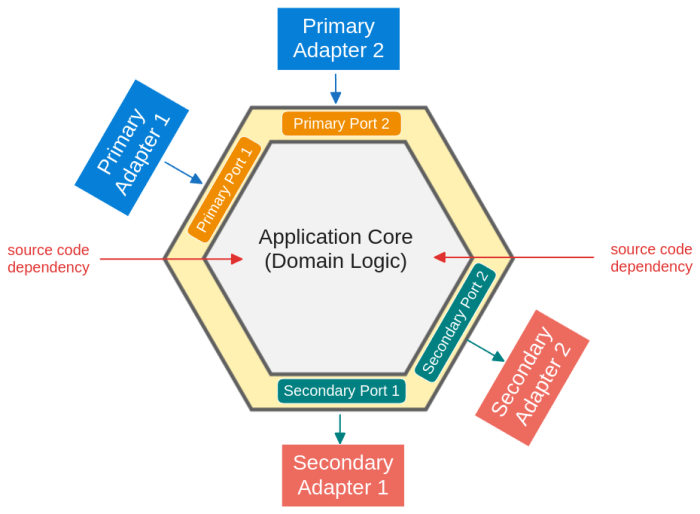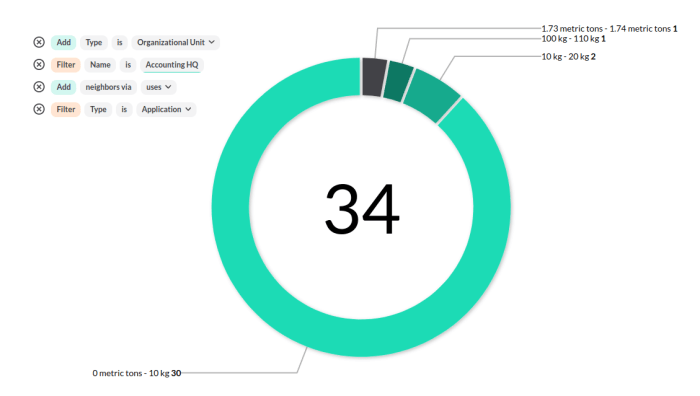Testability is paramount in modern software development, ensuring maintainability, flexibility, and scalability. Hexagonal architecture, with its emphasis on separating application logic from external dependencies, offers significant advantages in this regard. This article delves into how testability, when applied to hexagonal designs, leads to more robust, adaptable, and ultimately successful software projects.
Understanding the benefits of testability within hexagonal architecture empowers developers to create applications that are easier to maintain, adapt to changing requirements, and scale efficiently. This article explores these benefits in detail, providing practical examples and insights into best practices.
Introduction to Testability

Testability in software development refers to the ease with which software components can be tested. A highly testable system allows developers to verify its functionality and correctness thoroughly and efficiently. This characteristic is crucial for building robust and reliable software applications.Testability is paramount in modern software projects, particularly those involving complex systems and numerous interacting components. It enables developers to proactively identify and fix bugs early in the development lifecycle, minimizing costly issues later on.
The efficiency of testing directly impacts the speed and cost of the overall development process.
Significance of Testability
Testability plays a critical role in reducing the overall time and cost associated with software development. By facilitating the creation of comprehensive test suites, developers can quickly and accurately validate the correctness and functionality of software components. This approach leads to fewer defects, less debugging time, and ultimately a lower total cost of ownership.
Role in Reducing Development Time and Costs
The benefits of testable code extend beyond reduced debugging time. By designing code for testability from the outset, developers create a modular and maintainable system. This modularity allows teams to easily isolate and fix defects, which translates to significant time savings in the long run. Furthermore, comprehensive test suites can automate much of the testing process, freeing up developers to focus on more complex and innovative tasks.
Consequently, projects with high testability typically have shorter development cycles and lower overall costs.
Example of a Testable Module
Consider a simple module for calculating the area of a rectangle. A testable implementation would encapsulate the calculation logic within a class, exposing only necessary input parameters and the output area. This promotes modularity and allows for independent testing of the calculation logic without needing to involve the surrounding code.“`javaclass RectangleCalculator public double calculateArea(double length, double width) return length – width; “`This class is straightforward and clearly defines its function.
It is easy to write unit tests to verify that the calculation works correctly for various input values.
Comparison: Testable vs. Non-Testable Code
| Characteristic | Testable Code | Non-Testable Code |
|---|---|---|
| Structure | Modular, well-defined functions and classes | Complex, monolithic code |
| Dependencies | Minimal dependencies; isolated components | High dependencies; intertwined code |
| Testing | Easy to write unit tests; comprehensive test coverage | Difficult to write unit tests; limited test coverage |
| Maintainability | Easy to understand and modify | Difficult to understand and modify |
Non-testable code, often characterized by complex logic and intertwined components, is harder to test and maintain. The lack of clear boundaries and well-defined interfaces makes it challenging to isolate and verify the functionality of individual parts. In contrast, testable code is structured in a way that allows developers to test specific components in isolation, increasing confidence in the correctness and reliability of the overall system.
Hexagonal Architecture Overview
Hexagonal architecture, also known as ports and adapters architecture, is a software design pattern that promotes a separation of concerns. It emphasizes decoupling the core application logic from external dependencies such as databases, APIs, or user interfaces. This separation enhances testability and maintainability by allowing independent development and testing of different components.This architectural style is particularly beneficial in complex systems where external dependencies may change frequently or evolve independently.
By abstracting these dependencies through well-defined interfaces, the core application logic remains unaffected, enabling greater resilience and flexibility.
Core Principles of Hexagonal Architecture
The core principles of hexagonal architecture revolve around the idea of isolating the core business logic from the surrounding infrastructure. This isolation facilitates independent development, testing, and deployment of different components. The core application logic, or “domain,” is at the heart of the system and is independent of any specific technology.
Benefits of Separating Application Logic from External Dependencies
By separating application logic from external dependencies, the core business logic becomes independent of specific technologies. This leads to several key benefits:
- Improved Testability: The core application logic can be tested in isolation without relying on external systems. Mocking or stubbing external dependencies allows for comprehensive unit tests that focus solely on the logic within the application.
- Enhanced Maintainability: Changes to external dependencies, such as database migrations or API updates, do not directly affect the core application logic. This minimizes the risk of introducing bugs and simplifies maintenance tasks.
- Increased Flexibility: The system can be easily adapted to new technologies or platforms. Changing a database, for instance, would only affect the adapter layer, leaving the core logic untouched. This enables faster adaptation to evolving technology landscapes.
- Improved Collaboration: The separation of concerns fosters better collaboration between development teams focusing on different aspects of the application. Teams can work independently on their respective components without affecting the work of others.
Diagram of a Typical Hexagonal Application Structure
The hexagonal architecture pattern is often visualized as a hexagon. The hexagon represents the core application logic, independent of external factors. Surrounding the hexagon are the adapters, which connect the core logic to external systems.
The diagram shows the core application logic (the hexagon) interacting with external systems (databases, APIs, user interfaces) through defined ports. Adapters translate the requests and responses between the ports and the core application logic. This arrangement allows the core logic to remain unchanged when external dependencies evolve.
Advantages of Using Ports and Adapters
Ports and adapters are crucial components of hexagonal architecture. They define clear interfaces between the core application and external systems.
- Abstraction of External Dependencies: Ports provide a standardized way to interact with external systems, hiding the implementation details. This promotes a clean separation of concerns, allowing the core logic to remain independent of the specific technology used.
- Improved Code Reusability: Common ports can be reused across different adapters, reducing code duplication and promoting modularity.
- Reduced Complexity: The separation of concerns reduces the complexity of the overall application by making it easier to understand and maintain. It makes it easier to test specific parts of the system in isolation, without needing to run the entire application.
- Testability: Adapters allow for the mocking or stubbing of external dependencies, making it easier to test the core application logic in isolation. This results in more robust and reliable software.
Benefits of Testability in Hexagonal Architecture
Hexagonal architecture, with its clear separation of concerns and well-defined interfaces, naturally lends itself to robust and comprehensive testing. Testability is not merely an added feature but a fundamental aspect of the architecture, enabling quicker development cycles, enhanced maintainability, and a greater degree of confidence in the application’s behavior. This strong emphasis on testability directly contributes to the long-term health and evolution of the software system.The inherent modularity of hexagonal architecture, coupled with its focus on testable interfaces, significantly enhances the maintainability of the application.
Changes in one part of the system are less likely to have unforeseen consequences in other areas, making the codebase easier to understand, modify, and debug. This predictability reduces the risk of introducing bugs during maintenance and enhances the overall longevity of the system.
Enhanced Maintainability
Testability in hexagonal architecture directly translates to maintainability. The well-defined interfaces and ports-and-adapters structure allow developers to modify internal components without affecting the external behavior of the application. This decoupling reduces the risk of introducing bugs during maintenance and enhances the overall longevity of the system. Modifications can be tested in isolation, ensuring minimal disruption to the entire system.
Improved Flexibility and Scalability
The testability of hexagonal architecture plays a pivotal role in the flexibility and scalability of the application. The modular nature of the design enables the independent scaling of specific components, allowing for greater adaptability to changing business needs. Testable interfaces provide a clear roadmap for adding new features or functionalities without impacting existing parts of the system. Testing individual components before integration minimizes risks associated with large-scale changes.
Comparison with Other Architectural Styles
Compared to other architectural styles, hexagonal architecture shines in its testability. For instance, monolithic architectures often lack clear separation of concerns, making it difficult to isolate and test components effectively. This can lead to brittle code and increased maintenance costs. The testable interfaces and well-defined ports-and-adapters structure of hexagonal architecture allow for a high degree of modularity and isolation, making it much easier to test different parts of the application independently.
Promotion of Code Reusability and Modularity
Testable interfaces and components are key enablers of code reuse and modularity. The defined interfaces promote the creation of reusable components that can be easily integrated into different parts of the application or even other applications. The well-defined contracts between modules facilitate easier understanding and implementation of changes. This structure fosters a more collaborative development environment where modules can be developed and tested independently, leading to a more efficient development process.
Unit Testing with Hexagonal Architecture

Unit testing is crucial for ensuring the quality and reliability of software components. In a hexagonal architecture, unit tests can be particularly effective because they isolate the core business logic from external dependencies, allowing developers to focus on the core functionality without worrying about the intricacies of the underlying infrastructure. This approach promotes maintainability and reduces the risk of introducing bugs.Testing in hexagonal architecture goes beyond just testing the application; it focuses on testing the interfaces (ports) and the implementation details (adapters) separately.
This allows for independent verification of each component, facilitating easier debugging and modification of the application’s core functionality.
Isolating Components in Hexagonal Applications
Unit tests in hexagonal architecture effectively isolate components by leveraging the port and adapter pattern. The core business logic, residing in the application layer, is decoupled from the external dependencies, such as databases or external APIs. This decoupling allows testing the application layer in isolation, making it easier to verify its behavior without the need to interact with the concrete implementations of the ports.
This separation is a key benefit, enabling comprehensive testing of the application’s core functionality.
Writing Unit Tests for Ports and Adapters
A structured approach to unit testing ports and adapters involves first defining clear test cases for each port. These tests should cover various scenarios, including normal cases, boundary conditions, and error handling. For example, testing a `PaymentPort` might involve checking successful payments, failed payments due to insufficient funds, and payments with invalid input data. Adapter tests should focus on validating the interaction between the adapter and the corresponding port.
For instance, a database adapter test should verify that data is correctly stored and retrieved according to the defined port interface.
The Role of Mocks and Stubs
Mocks and stubs are essential tools for unit testing in hexagonal applications. Mocks simulate the behavior of external dependencies, allowing the testing of the application layer without needing actual external resources. Stubs, on the other hand, provide pre-defined responses to method calls, often used in situations where you need to control the output or return values from external dependencies.
The appropriate use of mocks and stubs is crucial to ensure isolated tests, allowing for effective testing of the application’s behavior without coupling to the concrete implementations of the adapters.
Example of a Unit Test for a Hexagonal Component
Consider a `CustomerService` class that interacts with a `CustomerRepository` (a port). The `CustomerService` implementation relies on the `CustomerRepository` to persist and retrieve customer data.“`java// CustomerService.javapublic class CustomerService private final CustomerRepository customerRepository; public CustomerService(CustomerRepository customerRepository) this.customerRepository = customerRepository; public Customer getCustomer(int customerId) return customerRepository.getCustomer(customerId); “`A unit test for the `CustomerService` might look like this (using a mock for `CustomerRepository`):“`java// CustomerServiceTest.javaimport org.junit.jupiter.api.Test;import org.mockito.Mockito;// …
other imports …class CustomerServiceTest @Test void testGetCustomer_validId() // Mock the CustomerRepository CustomerRepository mockRepo = Mockito.mock(CustomerRepository.class); Customer customer = new Customer(1, “John Doe”); Mockito.when(mockRepo.getCustomer(1)).thenReturn(customer); CustomerService service = new CustomerService(mockRepo); Customer retrievedCustomer = service.getCustomer(1); // Assertions assert retrievedCustomer.getId() == 1; assert retrievedCustomer.getName().equals(“John Doe”); “`This example demonstrates how a mock (`mockRepo`) isolates the `CustomerService` from the actual `CustomerRepository` implementation, allowing for focused testing of the `CustomerService`’s behavior.
Integration Testing in Hexagonal Architecture
Integration testing in hexagonal architecture focuses on verifying the interactions between different components, specifically the interplay between the application core (domain logic) and the external systems (adapters). This crucial step ensures that the different parts of the system work seamlessly together, fulfilling the system’s overall functionality. Successful integration testing provides confidence that the application behaves as expected when interacting with external services and data sources.
Strategies for Testing Port-Adapter Interactions
Proper testing of port-adapter interactions is essential to guarantee that the application core functions correctly with external systems. Strategies for this involve isolating the core application from external dependencies and creating test doubles for these dependencies. These test doubles simulate the behavior of external services or data stores, enabling focused testing of the application’s internal logic. This approach minimizes the impact of external factors on the testing process.
Strategies for Testing Dependencies
A key aspect of integration testing is verifying interactions with various dependencies. A comprehensive strategy involves creating test doubles for each dependency. This allows for controlled interaction with each dependency, isolating the system under test from external fluctuations. For example, a database interaction might be simulated using an in-memory database. This ensures that the test environment is stable and predictable.
Example of an Integration Test
Consider a scenario where an application processes user orders. The application core (domain logic) defines the order processing rules, while the external systems include a payment gateway and an inventory management system.
- The integration test would involve simulating a payment gateway using a mock object. This mock object would return predefined responses to the payment gateway interactions.
- Similarly, the inventory management system would be mocked to return predefined inventory levels.
- The test would then invoke the application core to process an order. It would verify that the application correctly interacts with the mock payment gateway and inventory management system.
- Crucially, the test would validate the expected behavior of the application core, such as the appropriate error handling in case of a payment failure or insufficient inventory.
This example highlights the importance of isolating the application core from external dependencies during integration testing. The mock objects allow for controlled interactions, enabling precise verification of the application’s response to various scenarios. This approach ensures that the system’s components work together as expected.
End-to-End Testing with Hexagonal Architecture
End-to-end (E2E) tests are crucial for validating the entire application flow in a hexagonal architecture. They ensure that all components, including the external services, function as expected when interacting with each other. This comprehensive verification is vital for identifying integration issues and guaranteeing the seamless operation of the system.
Verifying the Entire Application Flow
E2E tests simulate real-world user interactions, mimicking the steps a user would take to complete a specific task within the application. These tests encompass all the layers of the application, from the user interface to the external services. They verify that the data flows correctly between different modules and that the application behaves as expected throughout the entire process.
This approach ensures that the system is robust and reliable.
Validating Interactions with External Services
Hexagonal architecture isolates external dependencies, enabling clear separation between the application core and external systems. E2E tests play a critical role in confirming the correct interaction with these external services. They validate that the application correctly sends requests, handles responses, and manages potential errors from the external resources. This verification is essential to maintain the integrity and reliability of the application’s interaction with external systems.
Importance of End-to-End Tests in Hexagonal Architectures
E2E tests are paramount in hexagonal architectures due to their ability to validate the complete system behavior, encompassing the interaction with external services. They offer a holistic perspective, ensuring that all components work together seamlessly. Without comprehensive E2E tests, issues related to data exchange, service communication, and error handling might remain undetected, potentially leading to system failures or unexpected behavior in real-world scenarios.
Structure of an End-to-End Test for a Hexagonal Application
A well-structured E2E test for a hexagonal application typically involves the following steps:
- Setup: This stage involves initializing the necessary components, such as creating test data, configuring external services, and preparing the application environment for testing. This ensures that all dependencies are properly set up before running the test.
- Action: This step executes the user interaction sequence. It simulates the actions a user would perform within the application, including inputting data, interacting with UI elements, and triggering specific functionalities.
- Assertion: This phase verifies the expected outcomes of the user interaction. It checks for the correct data flow, the successful interaction with external services, and the desired state of the application. Assertions should cover various scenarios, including success, failure, and edge cases.
- Teardown: This step involves cleaning up the test environment after the test execution. This may involve deleting test data, resetting external service configurations, and ensuring that the application returns to a known state for subsequent tests.
Testability in the Context of Specific Dependencies
Testability is a critical aspect of software development, particularly when dealing with complex applications involving various external dependencies. Hexagonal Architecture, with its focus on separating application logic from external concerns, significantly enhances testability by isolating the core application from these dependencies. This allows developers to test the application’s core functionality independently of external systems, leading to more robust and reliable software.By leveraging the principles of Hexagonal Architecture, developers can create testable interfaces for external systems, such as databases, APIs, and message queues.
This modular approach facilitates the creation of mock objects that simulate the behavior of these external dependencies during unit testing, thereby isolating the application code from the complexities of the external world. This significantly reduces the time and effort required for testing and enhances the overall quality of the software.
External Database Interactions
Testability with external databases is greatly improved through the use of mock or stub implementations. The Hexagonal Architecture pattern encourages the creation of a repository interface that abstracts the database interaction. This interface can be easily mocked during unit testing, allowing developers to test the application logic without needing a live database connection. This isolation enables fast and frequent testing, significantly reducing the risk of introducing errors during integration.
Furthermore, using a repository interface promotes code reuse, making it easier to switch between different database implementations in the future without impacting the core application logic.
Third-Party API Integration
Maintaining testability with third-party APIs hinges on creating a well-defined interface that isolates the application from the API’s specifics. This interface acts as a contract, defining the expected input and output. Using mock objects for the API during unit testing ensures that the application’s behavior can be thoroughly validated without relying on the actual API. By adhering to this principle, developers can easily update the underlying API implementation without affecting the application logic.
This ensures adaptability and flexibility in handling API changes.
Complex Message Queue Interactions
Testing applications that interact with message queues, such as RabbitMQ or Kafka, requires careful consideration of testability. Hexagonal Architecture facilitates this by abstracting the message queue interaction into a well-defined service interface. This interface can then be mocked during unit testing, allowing the application’s logic to be tested in isolation. Using a mock queue implementation eliminates the need for real-time message delivery, allowing tests to run quickly and reliably.
This approach prevents dependencies on external message queues, enabling developers to thoroughly test the application logic without the complexities of message processing.
UI Framework Impact
The choice of UI framework, whether it’s React, Angular, or Vue.js, doesn’t fundamentally affect the testability principles embedded within the Hexagonal Architecture. The key lies in maintaining a clear separation of concerns between the UI and the application’s core logic. The Hexagonal Architecture pattern ensures that the UI interacts with the application logic through a well-defined interface, allowing for independent testing of both the UI and the core application logic.
This approach promotes the ability to test UI interactions without relying on the specific UI framework. This approach ensures testability and maintainability irrespective of the chosen framework.
Best Practices for Testable Hexagonal Designs
Crafting testable hexagonal applications requires a mindful approach to design. By adhering to specific guidelines and best practices, developers can ensure their applications are not only maintainable but also readily testable at various levels, from unit to end-to-end. This fosters a robust and adaptable system that can effectively respond to evolving business requirements.Adherence to testability principles in hexagonal architecture facilitates quicker and more reliable testing, ultimately improving the overall quality and stability of the application.
This also allows for easier adaptation to future changes, as well as quicker debugging and problem resolution.
Structuring Hexagonal Applications for Maximum Testability
Effective structuring of hexagonal applications is crucial for testability. The core principle involves isolating application logic from external dependencies. This separation allows for the creation of independent units that can be tested in isolation. This also helps to mitigate the risk of unforeseen side effects when modifying or updating the application’s components.
- Define clear boundaries between the core application logic and external interactions. This involves using ports and adapters to decouple the application from specific implementations.
- Favor interfaces over concrete implementations. Defining interfaces for external dependencies allows for the substitution of mock or stub implementations during testing, which is essential for isolating the application’s core logic.
- Design modules for independent testing. Break down the application into smaller, independent modules whenever possible. This facilitates testing individual components without affecting others. These modules should ideally have well-defined responsibilities and minimal dependencies.
Defining Interfaces in Hexagonal Applications
Well-defined interfaces are the cornerstone of testability in hexagonal architecture. Interfaces act as contracts between different components, specifying the expected behavior without revealing the implementation details. This decoupling is essential for testing, as it allows for the creation of mock objects that mimic the behavior of the dependencies without the need for the actual implementation.
- Keep interfaces focused and concise. Avoid overly complex interfaces that mix unrelated functionalities. A well-defined interface should encapsulate a single, focused responsibility.
- Use clear and descriptive naming conventions for interfaces. The name should accurately reflect the purpose and behavior of the interface. This promotes clarity and understanding for developers working with the code.
- Document interfaces thoroughly. Including comprehensive documentation for interfaces is critical for understanding the expected behavior and usage. This helps to maintain consistency and avoid misunderstandings.
Avoiding Tight Coupling to Improve Testability
Tight coupling between components can significantly hinder testability. The goal is to minimize dependencies between modules and promote independent testing. This decoupling allows for isolating and testing components without the complexities of interacting with other, interdependent components.
- Minimize direct dependencies between components. Favor using interfaces and dependency injection to decouple components.
- Employ dependency injection to inject dependencies into components. This enables the use of mock objects during testing, which significantly improves testability.
- Leverage dependency inversion principle. This principle promotes designing systems with abstractions, reducing the reliance on specific implementations.
Coding Standards Focused on Testability within Hexagonal Architecture
Consistent coding standards play a vital role in maintaining testability. These standards ensure that code is well-structured, readable, and easy to test. This approach to development makes the codebase more manageable, allowing developers to confidently make changes and improvements without fear of introducing unexpected errors.
- Prioritize modularity and separation of concerns. Structure code into distinct, well-defined modules with clear responsibilities. This promotes better understanding and maintenance.
- Adhere to consistent naming conventions for variables, methods, and classes. This enhances code readability and reduces ambiguity.
- Utilize meaningful comments to explain complex logic or design decisions. Clear comments contribute to better understanding of the code, which is vital for both developers and testers.
Tools and Technologies for Hexagonal Testing
Hexagonal architecture, by its nature, promotes testability through clear separation of concerns. This separation allows for focused testing of individual components without the complexities of interacting with external systems. This section explores the tools and technologies frequently used to effectively test hexagonal applications, emphasizing their benefits and drawbacks within the context of a development workflow.Effective testing of hexagonal applications requires tools that support the decoupled nature of the design.
These tools enable focused testing of components, reducing dependencies and ensuring confidence in the software’s behavior.
Common Testing Frameworks
Various frameworks facilitate the development of robust unit, integration, and end-to-end tests for hexagonal architectures. Their effectiveness depends on the specific needs of the project and the chosen testing strategy.
- JUnit (Java): A widely adopted unit testing framework for Java, JUnit provides annotations, assertions, and test runners to facilitate writing and executing unit tests. JUnit’s extensive community support and maturity make it a reliable choice for Java-based hexagonal applications. A drawback is its reliance on a Java runtime environment. This is a common limitation for other languages.
JUnit’s flexibility allows for different testing strategies, but it may not be as well-suited for specific testing needs like mocking or advanced integration testing.
- Mockito (Java): A mocking framework often paired with JUnit, Mockito allows developers to create mock objects that simulate external dependencies. This enables isolating units under test from external systems and their complexities. Mockito’s strength lies in its ease of use for mocking interactions and its comprehensive support for various types of mocks. However, it is tied to Java and its associated ecosystem.
- RSpec (Ruby): RSpec is a popular Behavior-Driven Development (BDD) framework for Ruby. It’s well-suited for creating tests that describe the expected behavior of the application. RSpec excels at generating clear, readable tests, which aids in understanding the system’s functionality. The drawback is its reliance on Ruby, limiting its direct application to other languages. Also, its focus on describing behavior might not be ideal for purely unit testing.
- pytest (Python): A flexible and popular framework for Python, pytest simplifies the process of writing and running unit tests. Its intuitive syntax and rich plugin ecosystem make it a practical choice for Python-based hexagonal designs. The extensive ecosystem supports diverse testing needs. A drawback is that the setup for running tests can be more involved than with some other frameworks.
- PHPUnit (PHP): A widely used unit testing framework for PHP. PHPUnit supports a variety of testing methods, including unit, integration, and acceptance tests. Its robust features and extensive community support make it a strong option for PHP projects. A limitation is that its core functionality is limited in handling complex mocking or advanced integration testing scenarios.
Integration of Testing Tools in the Development Workflow
A well-integrated testing process ensures that testing is an inherent part of the development cycle, promoting early issue detection and high-quality software.
- Continuous Integration (CI): Implementing CI tools like Jenkins, GitLab CI, or CircleCI integrates tests into the build process. Each code change triggers automated tests, ensuring immediate feedback on code quality. This practice identifies integration issues early, enhancing development efficiency and reducing rework.
- Test-Driven Development (TDD): Adopting TDD requires writing testsbefore* the code they are meant to validate. This approach ensures the code meets the requirements specified in the tests. TDD promotes a more thorough design and helps developers understand the intended behavior of the code.
- Code Coverage Tools: Tools like JaCoCo (Java), coverage.py (Python), or PHPUnit’s built-in coverage reporting can measure the percentage of code executed during testing. These metrics assist in identifying untested parts of the application, enabling developers to focus on areas that require more attention.
Comparison of Testing Frameworks
| Framework | Language | Features | Benefits | Drawbacks |
|---|---|---|---|---|
| JUnit | Java | Unit testing, annotations, assertions | Mature, well-documented, extensive community | Reliance on Java ecosystem |
| Mockito | Java | Mocking | Easy mocking, interaction verification | Tied to Java |
| RSpec | Ruby | BDD, clear descriptions | Readable tests, behavior-driven | Ruby-specific |
| pytest | Python | Flexible, plugins | Intuitive syntax, rich ecosystem | Potentially more involved setup |
| PHPUnit | PHP | Unit, integration, acceptance tests | Robust, extensive community | Limited advanced mocking support |
Real-World Examples and Case Studies
Understanding the practical application of testability within hexagonal architecture is crucial. Real-world examples demonstrate how testability, facilitated by this architectural style, can lead to more robust, maintainable, and efficient software. This section explores successful implementations, highlighting the benefits and contrasting them with situations where poor testability hindered development.
A Case Study: E-commerce Platform
A hypothetical e-commerce platform, utilizing hexagonal architecture, experienced significant challenges in updating its payment gateway integration. Without proper testability, changes to the payment processing logic proved difficult to isolate and test, leading to delays and increased risk of introducing bugs. The lack of clear separation between the application core and the external payment gateway impacted the speed of testing.
This scenario highlights how testability within a hexagonal structure enables effective isolation and targeted testing of specific components, allowing developers to confidently implement changes without widespread disruption. By utilizing the hexagonal architecture’s layered structure, the e-commerce platform could isolate the payment gateway module, enabling unit tests to validate its behavior without depending on external factors. This would allow for a more rapid and controlled update process.
Testable vs. Non-Testable Feature Implementation
Consider the implementation of a new user authentication feature.
- Testable Approach: Employing hexagonal architecture, the authentication logic is encapsulated within an adapter, allowing for clear separation from the user repository and external authentication services. This design promotes unit testing, allowing for the verification of authentication logic independently of the database or external API. The use of mocks and stubs for the external dependencies allows for focused testing of the core authentication logic, minimizing external dependencies and improving overall maintainability.
- Non-Testable Approach: In contrast, a non-testable approach might directly integrate the authentication logic with the database interaction. This approach makes unit testing difficult and time-consuming, as changes to the database or authentication services would impact the unit tests. Integration testing becomes significantly more complex, potentially hindering the identification and isolation of errors. Integration with the database would need to be tested along with the authentication logic, increasing the testing effort and potentially causing errors to be overlooked during testing.
A Real-World Example: Financial Transaction System
A financial transaction system, built using hexagonal architecture, successfully leverages testability to manage complex transaction processing. The system is designed with clear separation of concerns, allowing for individual unit tests to be written for different components of the transaction process. This ensures a high degree of confidence in the correctness of the transaction logic, minimizing errors. The system’s adapters were designed to be replaceable, facilitating easy changes to the underlying payment processing systems or database providers without impacting the core application logic.
This adaptability was critical to the system’s ability to handle future changes in the payment processing environment.
Problems Caused by Poor Testability
A hexagonal architecture-based inventory management system encountered challenges when faced with frequent updates to the product catalog API. The lack of clear separation between the application core and the catalog API made integration testing complex and time-consuming. This led to a significant increase in testing time, making it difficult to ensure that changes to the API did not introduce unforeseen bugs.
The system’s design lacked appropriate isolation for testing, leading to potential errors that could have been detected earlier through better testing practices. These challenges demonstrate the importance of adhering to the hexagonal architecture principles to maintain high testability, leading to better quality and stability.
Summary

In conclusion, integrating testability into hexagonal architecture yields numerous advantages, from improved maintainability to enhanced scalability and code reuse. By employing a structured approach to unit, integration, and end-to-end testing, developers can create applications that are more resilient, adaptable, and easier to evolve over time. The key takeaway is that testability, when embraced within hexagonal architecture, leads to higher quality, more sustainable software solutions.
Common Queries
What are the key benefits of using ports and adapters in hexagonal architecture, in the context of testability?
Ports and adapters decouple the application logic from external dependencies, allowing for easier isolation and mocking during testing. This enables effective unit testing, as you can easily replace external dependencies with test doubles (mocks or stubs) without affecting the application core.
How does hexagonal architecture promote code reuse in a testable context?
The modularity inherent in hexagonal architecture allows components to be reused across different parts of the application and even in other projects. This reuse is further facilitated by the testability built into the architecture, as well-defined interfaces and isolated components can be easily integrated into various contexts.
What are some common challenges faced when testing with complex external dependencies (e.g., databases, APIs)?
Testing with complex external dependencies can be challenging due to their inherent variability and potential for unexpected behavior. Hexagonal architecture, however, mitigates this by abstracting interactions with these dependencies through well-defined interfaces. This allows for controlled and consistent testing scenarios.
How does a well-defined testing strategy improve the overall maintainability of a hexagonal application?
A robust testing strategy, encompassing unit, integration, and end-to-end tests, helps ensure that changes to the application don’t introduce regressions. This, in turn, leads to a more maintainable codebase, as issues are identified and addressed early in the development cycle.


